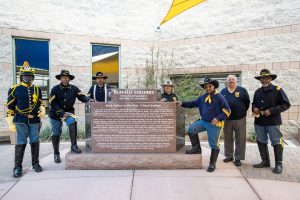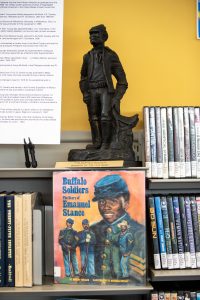I jumped at the opportunity to sit down with Troopers Jon Covington, Floyd Gray, and Lee O. Easter Jr. to discuss the Buffalo Soldiers special collection, which launched at Quincie Douglas Library in February 2023 during Black History Month.
Before we get to the collection though, it’s important to address the Tucson Buffalo Soldiers Memorial Plaza that was unveiled at the Quincie Douglas Center in May 2021. The memorial focuses on the accomplishment of those black soldiers known as the “Buffalo Soldiers.” Features of the memorial are the memorial monument, the history panels, and unit flags.
A memorial monument made of North American pink granite to withstand our high temperatures shows the Arizona Territory locations where the soldiers served. It also recognizes and honors the Buffalo Soldiers’ service, sacrifice, and accomplishments while they were stationed in the Arizona Territory.
The six surrounding history panels, also designed to withstand the high summer temperatures, highlight a broader history of the Buffalo Soldiers including establishing of first black units, their commanders, the nation’s first black officers, the military campaigns that involved the Buffalo Soldiers, national park service and those chaplains who served the soldiers.
Flagpoles were installed about a year after the memorial opened to display the regimental flags of the 9th and 10th Cavalries and the 24th and 25th Infantries. It all sits beneath sail shades and alongside benches where visitors can learn and reflect.
The memorial was a collaboration between the City of Tucson Ward 5 Office, Tucson Parks and Recreation, and the Greater Southern Arizona Area Chapter (GSAAC) of the Buffalo Soldiers 9th and 10th (Horse) Cavalry Association, of which Troopers Covington, Gray, and Easter are members.
The memorial offers visitors a visual representation of one of the most famed units in the history of American Armed Forces, but it also paved the way for the special collection at Quincie Douglas Library. Trooper Gray told me, “During a time when people are tearing each other down, our memorial and collection show positive contributions to the nation’s social fabric and history.”
Trooper Covington said, “The memorial gives people a bigger picture of how the Buffalo Soldiers fits into America’s history.” Trooper Gray continued, “It—and the collection—are icebreakers to the conversation about Buffalo Soldiers in Arizona.”
The collection is impressive and includes more than books. Certified copies of paintings, newspapers clippings, military records, and sculptures sit atop and around the shelves holding such important books as Buffalo Soldiers in the West, Child of the Fighting Tenth, Voices of the Buffalo Soldier, and many more. It also includes materials donated by local historian Dr. John Langellier, whose publications include Fighting for Uncle Sam: Buffalo Soldiers in the Frontier Army, Southern Arizona Military Outposts, Scouting with the Buffalo Soldiers. Donations also came from the collection of Morgan Maxwell Jr., whose father served as the principal of the Dunbar School—the only school for Black children in a segregated Tucson—beginning in 1940.
Trooper Covington remarked, “I enjoy seeing people come in and do research. It’s the premier African American history spot and it’s right here in Tucson. It adds to the history that is part of this country. You’d be surprised how many people ask, ‘Who are the Buffalo Soldiers?’” Sammie Parker, who sat on the Tucson Buffalo Soldier Monument Committee in 2009, has visited the memorial, and hopes that the memorial starts to answer that question in a good way. He said, “[They are] the brave Americans who protected and served on the western frontier of our great nation for many years.”
It’s fitting that this unique Buffalo Soldier and African American collection is kept at Quincie Douglas Library. The library—and neighborhood center—are located at 36th Street and Kino Avenue in the South Park neighborhood, one of Tucson’s five historic Black neighborhoods.
Trooper Easter said, “This collection is an ongoing growth of history and it’s very fitting to have it at the library where it’s accessible to all.”






